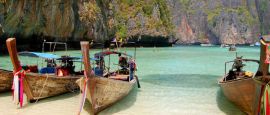Thailand History, Language and Culture
History of Thailand
Thailand's history is shaped by shifting kingdoms, regional cultures and a long tradition of independence. Early civilisations flourished in the north and northeast, but it was the rise of the Sukhothai Kingdom in the 13th century that marked the beginning of what is often considered the first Thai state. Sukhothai was followed by Ayutthaya, a powerful and cosmopolitan kingdom that grew into one of Southeast Asia's great trading centres before falling in 1767.
The modern era began with the establishment of the Chakri dynasty in 1782 and the founding of Bangkok as the capital. During the 19th century, Thailand skillfully navigated the pressures of European colonial expansion, remaining the only Southeast Asian nation never to be colonised. Reforms in administration, education and infrastructure helped modernise the country while maintaining its cultural identity.
The 20th century brought significant political change, including the end of absolute monarchy in 1932 and a series of constitutional shifts over the decades. Thailand played strategic roles during global conflicts and later emerged as a regional economic leader. Today it blends ancient traditions with modern development, and its layered history is still visible in its temples, palaces and historic towns.
Did you know
• Thailand is the only country in Southeast Asia that was never colonised by a European power, a point of great national pride.
• Bangkok's full ceremonial name is one of the longest place names in the world, containing more than 160 characters in Thai.
• The great reclining Buddha at Wat Pho in Bangkok measures 46 metres long and is covered in gold leaf, with mother-of-pearl inlaid feet depicting auspicious symbols.
Language in Thailand
The official language of Thailand is Thai, a tonal language with its own distinctive script. It is spoken throughout the country, though regional dialects such as Northern Thai, Isan and Southern Thai add variety to everyday communication.
English is commonly understood in major cities, tourist areas, hotels and restaurants, particularly among younger people and those working in the tourism industry. Thailand is also home to several minority languages, including Karen, Malay (in the far south) and various hill-tribe languages in the northern highlands.





 You know where
You know where